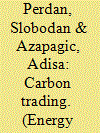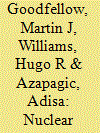|
|
|
Sort Order |
|
|
|
Items / Page
|
|
|
|
|
|
|
| Srl | Item |
| 1 |
ID:
109636


|
|
|
|
|
| Publication |
2011.
|
| Summary/Abstract |
This paper looks at the greenhouse gas (GHG) emissions trading schemes and examines the prospects of carbon trading. The first part of the paper gives an overview of several mandatory GHG trading schemes around the world. The second part focuses on the future trends in carbon trading. It argues that the emergence of new schemes, a gradual enlargement of the current ones, and willingness to link existing and planned schemes seem to point towards geographical, temporal and sectoral expansion of emissions trading. However, such expansion would need to overcome some considerable technical and non-technical obstacles. Linking of the current and emerging trading schemes requires not only considerable technical fixes and harmonisation of different trading systems, but also necessitates clear regulatory and policy signals, continuing political support and a more stable economic environment. Currently, the latter factors are missing. The global economic turmoil and its repercussions for the carbon market, a lack of the international deal on climate change defining the Post-Kyoto commitments, and unfavourable policy shifts in some countries, cast serious doubts on the expansion of emissions trading and indicate that carbon trading enters an uncertain period.
|
|
|
|
|
|
|
|
|
|
|
|
|
|
|
|
| 2 |
ID:
150921


|
|
|
|
|
| Summary/Abstract |
This paper presents for the first time an integrated life cycle sustainability assessment of the electricity sector in Turkey, considering environmental, economic and social aspects. Twenty life cycle sustainability indicators (11 environmental, three economic and six social) are used to evaluate the current electricity options. Geothermal power is the best option for six environmental impacts but it has the highest capital costs. Small reservoir and run-of-river power has the lowest global warming potential while large reservoir is best for the depletion of elements and fossil resources, and acidification. It also has the lowest levelised costs, worker injuries and fatalities but provides the lowest life cycle employment opportunities. Gas power has the lowest capital costs but it provides the lowest direct employment and has the highest levelised costs and ozone layer depletion. Given these trade-offs, a multi-criteria decision analysis has been carried out to identify the most sustainable options assuming different stakeholder preferences. For all the preferences considered, hydropower is the most sustainable option for Turkey, followed by geothermal and wind electricity. This work demonstrates the importance for energy policy of an integrated life cycle sustainability assessment and how tensions between different aspects can be reconciled to identify win-win solutions.
|
|
|
|
|
|
|
|
|
|
|
|
|
|
|
|
| 3 |
ID:
109652


|
|
|
|
|
| Publication |
2011.
|
| Summary/Abstract |
There is currently an international drive to build new nuclear power plants, bringing about what is being termed a "nuclear renaissance". However, the public perception of nuclear energy has historically been, and continues to be, a key issue, particularly in light of the Fukushima nuclear incident. This paper discusses the disparity between perceived and calculated risks based on the last four decades of research into risk perception. The leading psychological and sociological theories, Psychometric Paradigm and Cultural Theory, respectively, are critically reviewed. The authors then argue that a new nuclear-build policy that promotes a broader approach to design incorporating a wider range of stakeholder inputs, including that of the lay public, may provide a means for reducing the perceived risk of a nuclear plant. Further research towards such a new approach to design is proposed, based on integrating expert and lay stakeholder inputs and taking into account broader socio-cultural factors whilst maintaining the necessary emphasis on safety, technological development, economics and environmental sustainability.
|
|
|
|
|
|
|
|
|
|
|
|
|
|
|
|
|
|
|
|
|